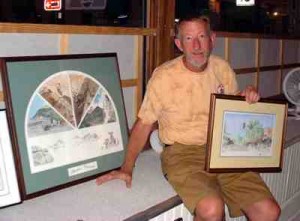Brief by Central Staff
Communications – October 2005 – Colorado Central Magazine
This month marks the 10th anniversary of local Internet service in Salida, Buena Vista, and Leadville. Before October of 1995, there were no local Internet Service Providers (ISPs, in the jargon). Then Rocky Mountain Internet, based in Colorado Springs, partnered with Ken Swinehart (who now runs Amigo.Net), to provide local access.
At Colorado Central, we naturally signed up right away for this dial-up service, and replaced a 9600-bps (bits per second) modem with a 14.4 kbps modem. As service improved and got more competitive, we upgraded to a 28.8-kbps modem, then 56-kbps.
Once broadband arrived in early 2004, we went with Bresnan Cable for about a year. The difference between dial-up and broadband?
It’s like going from a well-pump in the yard to indoor plumbing. In both cases, you can get what you need when you need it, but it’s so much faster and easier to just turn on the faucet indoors.
The cable service was excellent, but we switched to Qwest DSL (Digital Subscriber Line) broadband last winter because it cost about half as much.
In our experience, Qwest DSL isn’t quite as fast or reliable as Bresnan Cable was, but Bresnan wasn’t enough better to be worth the extra $30 a month – to us. (Those with surplus cash, may not agree.)
Once broadband arrived, so did Wi-Fi — high-speed wireless Internet connections. Often these are encrypted and restricted to, say, people in a given office so that they can access the Internet and move data between their computers.
But some are public, offering Internet access to any visitor with a portable computer equipped with a wireless network device. To test just how public, we conducted some tests in Salida.
(For you byteheads, the test machine was an IBM Thinkpad T-22 laptop running Windows 2000 Professional with some generic $14.95 PCMIA 802.11g wireless network adapter.)
We are pleased to report we were able to get on the ‘Net from all five places. We started at Sacred Grounds Coffee on U.S. 50, then moved downtown to the Book Haven, Cowgirl Coffee, Salida Regional Library, and Bongo Billy’s.
The weakest connection (but still more than adequate) was at the library. Vic Mabus, the resident digital guru there, said that the signal would have been stronger if we hadn’t set up in the children’s room, which is farthest from the antenna. (The only reason we set up there was that there was an empty table in that room, whereas all the others were in use.)
The strongest connection was at Bongo Billy’s, and we didn’t even go indoors there; we ran the test from the outdoor deck, and it worked so well we didn’t even bother to try the interior.
At any rate, in ten years the Internet here has gone from a long-distance novelty to an almost essential piece of infrastructure that more-or-less permeates the atmosphere around town. We couldn’t have imagined that in 1995, so we’ll avoid guessing about connections in 2015.

